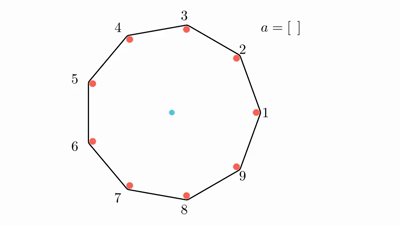Preparando MOJI
Doremy has $$$n+1$$$ pegs. There are $$$n$$$ red pegs arranged as vertices of a regular $$$n$$$-sided polygon, numbered from $$$1$$$ to $$$n$$$ in anti-clockwise order. There is also a blue peg of slightly smaller diameter in the middle of the polygon. A rubber band is stretched around the red pegs.
Doremy is very bored today and has decided to play a game. Initially, she has an empty array $$$a$$$. While the rubber band does not touch the blue peg, she will:
Doremy wonders how many possible different arrays $$$a$$$ can be produced by the following process. Since the answer can be big, you are only required to output it modulo $$$p$$$. $$$p$$$ is guaranteed to be a prime number.
 game with $$$n=9$$$ and $$$a=[7,5,2,8,3,9,4]$$$ and another game with $$$n=8$$$ and $$$a=[3,4,7,1,8,5,2]$$$
game with $$$n=9$$$ and $$$a=[7,5,2,8,3,9,4]$$$ and another game with $$$n=8$$$ and $$$a=[3,4,7,1,8,5,2]$$$ The first line contains two integers $$$n$$$ and $$$p$$$ ($$$3 \leq n \leq 5000$$$, $$$10^8 \le p \le 10^9$$$) — the number of red pegs and the modulo respectively.
$$$p$$$ is guaranteed to be a prime number.
Output a single integer, the number of different arrays $$$a$$$ that can be produced by the process described above modulo $$$p$$$.
4 100000007
16
1145 141919831
105242108
In the first test case, $$$n=4$$$, some possible arrays $$$a$$$ that can be produced are $$$[4,2,3]$$$ and $$$[1,4]$$$. However, it is not possible for $$$a$$$ to be $$$[1]$$$ or $$$[1,4,3]$$$.